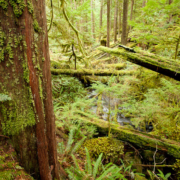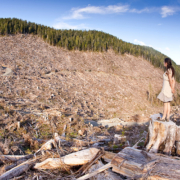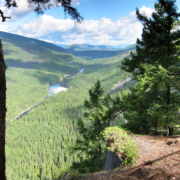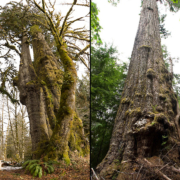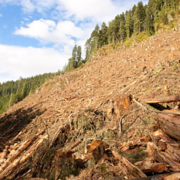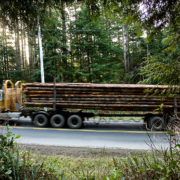The Ancient Forests of Cortes Island #2: The Carrington Bay Children’s Forest
There is very little common ground between Island Timberlands’ logging methods and how the community would like forestry to be done on Cortes—but as this is private managed forestland, there’s not a whole lot they can legally do about it. And, as long as the province is benefitting from these operations through their investment wing, the BC Investment Management Corporation (BCIMC)—which manages all of the public sector pension funds—there will continue to be a disturbing incentive for them to maintain the status quo, regardless of what communities may want.
According to Ken Wu of the Ancient Forest Alliance (AFA), “Ultimately, if these lands are going to be protected, they need to be purchased.” But despite the fact that Brookfield Asset Management purchased their coastal timber holdings for bottom dollar, they are now insisting on highly inflated prices. (We will discuss a concrete example of this in two weeks when we explore the Whaletown Commons.) How on earth are humble Cortesians supposed to purchase these forestlands for such astronomical prices?
One option is to engage a Land Trust organization. BC has two provincial land trusts to choose from: Nature Trust and The Land Conservancy. And then there are some smaller, more localized land trusts, such as the Islands Trust. These groups raise tens of millions of dollars each year for the preservation of special areas that happen to fall on private land. But once the lands are purchased, how does a community ensure that those lands remain protected in perpetuity?
In addition to raising funds, land trusts also help with the legal process of placing conservation covenants on privately held land. A conservation covenant is when a private landowner makes a legally binding promise to protect the land in specific ways of his or her choosing. The land trust agrees to monitor the covenant and ensures that its promise is being upheld. Covenants are very flexible as to what one can specify to be protected or restricted on the land, and they are attached to the land title forever—regardless of who owns it in the future.
Or, you could do what they did on Cortes and create your very own Trust. The Forest Trust for the Children of Cortes Island was just incorporated this past summer, with the sole purpose of purchasing and protecting with covenants what is known as the Children’s Forest. This area lies at the mouth of Carrington Lagoon, adjacent to Carrington Bay Regional Park. It contains some of the only stands of old sitka spruce trees on the island. James Creek runs right through the forest and supports spawning salmon. The origin of the name comes from the area’s history of being a place where students would come and learn about forest stewardship, ecology, mushrooms, wildlife, and salmon enhancement.
Island Timberlands, to its credit, has acknowledged the uniqueness of this area and has left it off its immediate logging plans. The company has engaged in a process with the Children’s Forest Trust to allow them some time to raise the necessary funds to be able to acquire the property. The next step is to agree on a fair price—which could number in the tens of millions. If Cortes Island is going to achieve this seemingly unatainable goal, they are going to need a lot of help from the outside world.
But with just two provincial land trusts in BC, there are not a whole lot of places that they can turn to. But even if they are able to get the funds they need to save this forest, the reality is that private land trusts will never be equipped to purchase all these endangered private lands fast enough to save them from liquidation. The only organization in BC with a budget large enough to make these purchases is the provincial government.
Up until 2008 the province had a land acquisition fund. However, since the recession, a fund has not been included in the budget. That is why the Ancient Forest Alliance has authored a petition calling on the provincial government to establish a BC Park Acquisition Fund of $40 million a year—or about 0.1% of the annual provincial budget.
Over ten years this fund would add up to $400 million and could be used to purchase lands with important ecological, cultural, and recreational value, to be added to the BC parks system. The petition also points out that, “For every $1 invested by the BC government in our parks system, another $9 is generated in the provincial economy through tourism revenues.” Not to mention the ecological services that a forest provides in purifying our air and water. (We will discuss ecological services next week in Green Valley.)
There is a compelling economic argument to be made for investing in a standing forest—simply to allow it to continue doing its job as a forest. But before that can happen with the Cortes Island Children’s Forest, Island Timberlands will have to agree to sell the land at fair value. And even if that does occur, the province will have to start making the acquisition of private forestlands a priority if communities like Cortes are going to survive, let alone purchase these lands. And no matter what, the Children’s Forest Trust is going to have a huge amount of fundraising on their hands.
But perhaps most importantly, for all the land that is going to remain in the hands of the corporations, there is a need for stronger regulations and enforcement of violations on Private Managed Forestland. Sensitive ecosystems and species at risk do not understand property lines. And the long-term effects of industrial logging practices have innumerable downstream consequences for neighboring communities. So the whole argument that says, “It’s their private land, they can do whatever they want.” Well, therein lies the problem—and I don’t buy it.
Next week we will take a journey into Green Valley, a luscious, mossy valley that purifies the drinking water for the people of Cortes Island. This is the next section of forestland in Island Timberlands’ logging plans.

